70MM Impressions from Oslo |
Read more at in70mm.com The 70mm Newsletter |
| Written by: Thomas Hauerslev. Cinema specifications by Jan E Olsen | Date: 31.01.2015 |
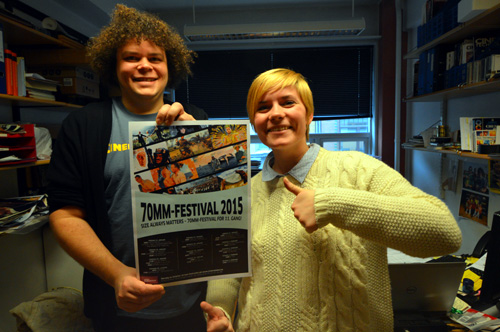 Curator
and organizer (and chief 70mm Troll) of the Oslo 70mm Festival, Jan E Olsen and
70mm festival guest Maria Hauerslev,
agrees "70MM IS OK".
Festival poster with information about all the films. Curator
and organizer (and chief 70mm Troll) of the Oslo 70mm Festival, Jan E Olsen and
70mm festival guest Maria Hauerslev,
agrees "70MM IS OK".
Festival poster with information about all the films.Are you familiar with films form Norway? No? The most popular Norwegian film ever made was "Flåklypa Grand Prix" from 1975. It sold 5 million tickets, which is not bad when the population is only 5 million people. The film was sold to almost every country in the world, and made a fortune. Personally I have not seen many films from Norway, I regret to say (at least I don't think I have). Three recent films do come to mind, and those are "Trolljegeren" (2010) which I utterly enjoyed, "Hodejegerne" (2011) is also an excellent thriller, and finally the epic "Kon-Tiki" (2012), which was given additional international attention with a nomination for an OSCAR that year. In my DVD collection I also have "O' Horten" (2007) waiting to be seen. One category of Norwegian films I HAVE seen, however, are the large format films. |
More in 70mm reading: 11th Oslo 70mm Festival, January 2015 70mm Festival in Oslo, 2015 Internet link: |
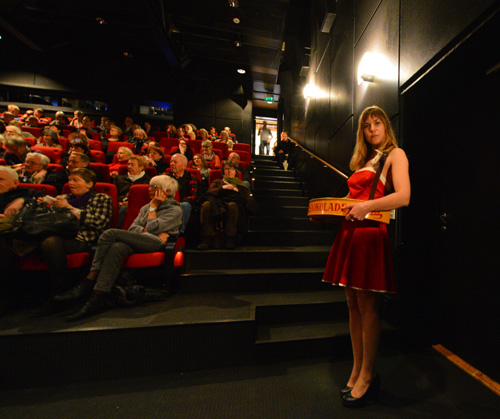 The
charming Freia
Chocolate Girl selling sweets from an authentic Freia chocolate tray during
intermissions and breaks The
charming Freia
Chocolate Girl selling sweets from an authentic Freia chocolate tray during
intermissions and breaksNorway has a very rich large format and 70mm heritage. In 1957 the tall ship Christian Radich, was starring in "Windjammer", filmed in Cinemiracle. The Norwegian engineer Jan Jacobsen developed the M.C.S.-70 65mm cameras in Germany, and in the beginning of the 1970s, Cinerama Releasing Corporation filmed "Song of Norway" in Super Panavision 70 on many locations in Norway. The latter is a hugely entertaining kitsch classic about the the composter (and national treasure) Edward Grieg. Often dismissed as being very very bad, it is partly directed by the legendary stuntman Yakima Canutt. Cinerama shows Norway as it is - and it is very funny and enjoyable. With its visible wig lines, reflections of camera equipment etc., it is sometimes referred to as a "documentary" by some 70mm aficionados, displaying the essence of Norwegian national character. All singing, all dancing. |
|
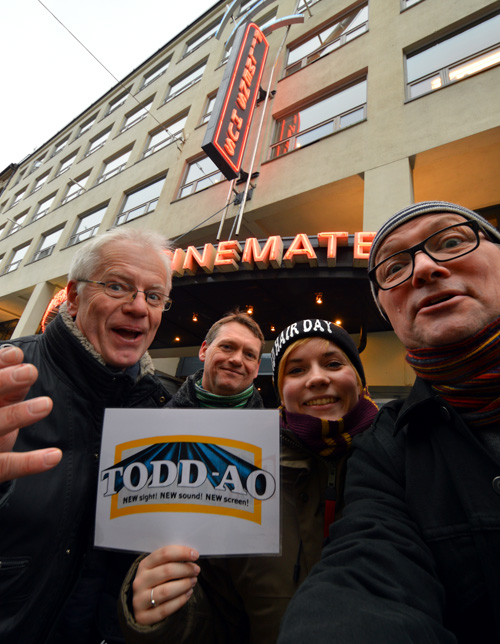 The
Danish 2015 delegation outside the Cinematek. Orla, Henning, Maria (with the
Todd-AO logo), and yours truly. The
Danish 2015 delegation outside the Cinematek. Orla, Henning, Maria (with the
Todd-AO logo), and yours truly.In 1991 Morten Skallerud premiered his 12 minutes short film "A Year Along the Abandoned Road". A nature animation film photographed with a 65mm Super Panavision camera. A few years later Hans-Kristian Bukholm produced the beautiful 65mm film "Svalbard - Arctic Seasons" for the Nansen Environmental and Remote Sensing Center in Bergen. in 2003 Morten Skallerud continued making nature animation film, only this time he decided to film in 65mm IMAX format for the 4 minutes short film "Where The Trains Used To Go". In 2007 the Bergen native and artist Ole Mads Sirks Vevle premiered his non-verbal 70mm short film "Tanakh Bibelen al-Quran". And before I forget, Paul Gerber also filmed the Super Panavsion 70 Disney EPCOT film "Norway" in Norway. On the cinema side the Norwegians have been on the technological forefront of large format exhibition. The dome shaped Colosseum with its gigantic curved screen was home to "Windjammer", as well as the premiere of the 70mm format in Norway, with the first film "Solomon and Sheeba" in Super Technirama 70. Todd-AO premiered two years later with "South Pacific" in 1960. Fast forward to 1996, it was the Norwegians who boldly asked 20th Century Fox to strike a 70mm print of "Independence Day" because they wanted to show it on a 40 meter wide screen at the Spektrum Hall, close to central Station. |
|
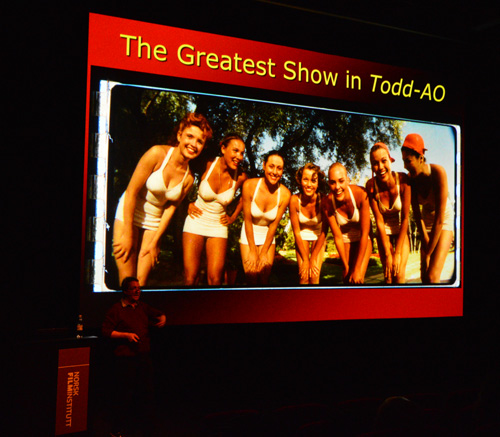 Lecture
about Todd-AO and 70mm. 76 guests saw the lecture, and 65mm demonstration
film. Lecture
about Todd-AO and 70mm. 76 guests saw the lecture, and 65mm demonstration
film. It paid off, and the following years a handful of 70mm prints were struck for the Norwegians. One of the 70mm organizers Mr. Torkel Sætervadet wrote The Advanced Projection Manual 10 years later in 2006 about the specific needs for repertory and archive cinemas. Including a chapter on how to show 70mm - properly. A must for all cinemas engaged in showing old films, and not just 70mm. A MUST for everyone - go buy it!!!!! Highly recommended. The Norwegians certainly have made their fingerprint on the 70mm world map. Compared to the size of the population they have been very active. Being Danish and their neighbour I proudly applaud their efforts - well done 70MM TROLLS! In 2000 the curator of the Oslo 70mm Festival, Jan Eberholst Olsen started regular 70mm screenings at the Cinematek in Oslo. This festival has gone from strength to strength and in 2015 it's the 11th festival of this sort. Previous festivals took place: 2000, 2001, 2002, 2003, 2004, 2005, 2007, 2009, 2010, 2013. |
|
Going to Oslo |
|
 Henning,
Orla, Maria and Morten. Morten directed and produced the 70mm short film "A Year
Along the Abandoned Road". The most popular short film in the history of
Norwegian film. Henning,
Orla, Maria and Morten. Morten directed and produced the 70mm short film "A Year
Along the Abandoned Road". The most popular short film in the history of
Norwegian film.In late 2014 Jan invited me to come to Oslo and give my lecture about Todd-AO titled, "The Early Days of Todd-AO", which chronicles what happened in the days following the premiere of "This is Cinerama" in 1952 and until the premiere of "Oklahoma!" in 1955. Originally written for the 2005 Widescreen Weekend, I have also given this lecture in Karlsruhe (2005) and Aalborg (2014). Since the first presentation the lecture has evolved somewhat. I might not say the same things every time, but it is essentially the same story. Richly illustrated it takes about 40 minutes and is followed by about 8 minutes of original 65mm 30 FPS footage in full ANSCO color. Fred Zinnemann filmed it personally in July 1953, "starring" actor Peter Graves, and the crew who was working with the new large format equipment. I happily accepted Jan's invitation and was eager to go. We did try to do this in 2013, but it did not work out. |
|
 70mm
film cans stored in hall way next to the projection room 70mm
film cans stored in hall way next to the projection roomJan asked me if there were any films I particularly liked to see in 70mm. "Exodus", "The Big Fisherman" or "MacKenna's Gold" I replied, since I am still short of seeing them in 70mm, before my 70mm title checklist is complete. Unfortunately none are available any longer in 70mm, so I settled for a double feature of "Doctor Zhivago" and "Lawrence of Arabia". That is 9 hours of film, including breaks. Then I also wanted to bring my daughter Maria, an avid film fan, seasoned 70mm festival goer (since age 8 in 2005) and a good 70mm Festival travel partner. She has never seen "Lawrence" in 70mm. A serious shortcoming in her upbringing, and I am certainly to blame for that. I now had the opportunity to correct this error. |
|
 The
Norwegian are Vikings and a tough people - imagine sitting outside in biting frost to
enjoy a drink. Never the less, that is what they do. The
Norwegian are Vikings and a tough people - imagine sitting outside in biting frost to
enjoy a drink. Never the less, that is what they do. I booked the SAS airfare, and started to work on the festival page and to update my lecture to customize it for a Norwegian audience. It is easy to go to Oslo - at least from Copenhagen. About one hour in the air, and Maria and I arrived in snow covered Norway. 22 minutes of fast trains leads you directly to Oslo Central station from the basement of the airport. Our hotel and the Cinematek is a 5 min walk from the station. All very convenient. We walked straight to the cinema to see Jan and drop the 65mm can I had brought in our suitcase. |
|
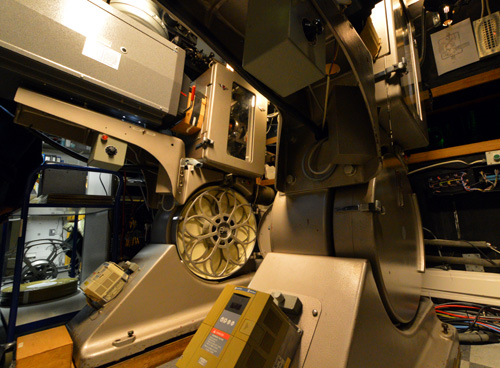 The
PHILIPS' grandmaster piece by chief engineer Jan Kotte, the DP70s of the Cinematek. 60 years old and
still the best 70mm machine ever developed. The
PHILIPS' grandmaster piece by chief engineer Jan Kotte, the DP70s of the Cinematek. 60 years old and
still the best 70mm machine ever developed.In the hallway to his office we saw all the 70mm transportation cans lined up film by film. I noticed the "Interstellar" 70mm print came from Copenhagen. As we were chatting Jan told us that the 2015 festival, by far had been the most successful 70mm festival since the beginning in 2000. Several shows have been sold out, including "South Pacific", "War and Peace" and "Samsara". More than 3700 tickets sold so far, and only a few tickets left. A presentation about the festival appeared on national television with more than a million viewers. Jan have also been interviewed on radio to talk about the festival. 70mm is indeed back and "to be seen on the big screen" in Oslo. |
|
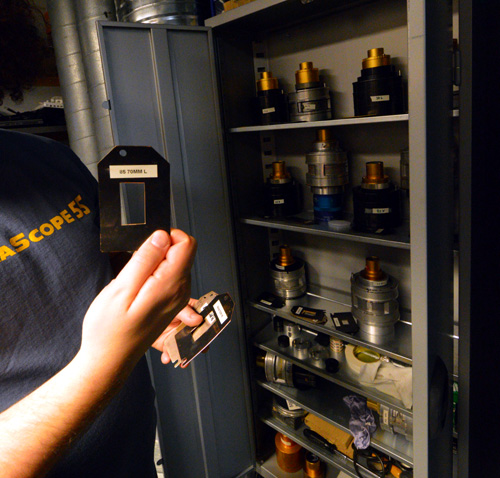 The
collection of projection lenses at the Cinematek. Basically treated as gold
dust, as there are not really any manufactures of projection lenses left any
longer The
collection of projection lenses at the Cinematek. Basically treated as gold
dust, as there are not really any manufactures of projection lenses left any
longerJan was sure this national television coverage had helped boost the ticket sales. After checking into our hotel, Maria and I met with Orla and Henning, who had flown in from Aalborg. On top of the Karl Johan pedestrian street, I "flashed" the Todd-AO Logo, when they came up to us. Big smiles and hand shakes, and then we were off to have some lunch. We decided to go to Aker Brygge and see what happened to the former IMAX cinema. It turned out it had been converted to several restaurants. Across the Brygge, we could see the pier where "Christian Radich" is moored when the ship is in Oslo. Today, it was out on the high seas somewhere. |
|
Previous Oslo Visits |
|
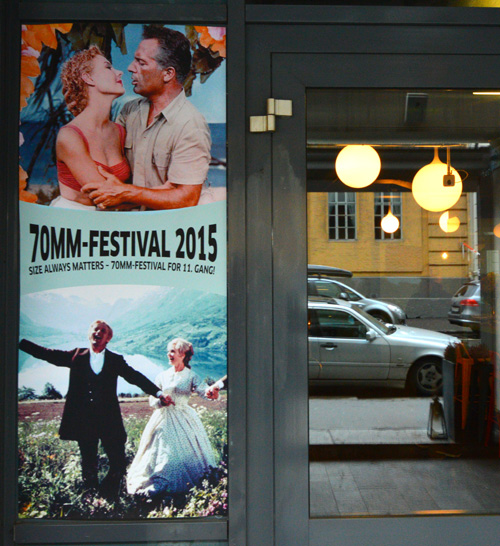 More
festival poster decoration outside the Cinematek, in Dronningensgate (The
Queen's Street) More
festival poster decoration outside the Cinematek, in Dronningensgate (The
Queen's Street)My first "movie" visit to Oslo had been in 1995 with Willem Bouwmeester to meet with Harald Tusberg, one of the stars from "Windjammer". We had meetings with Harald and Oslo Kinematografer about the possibility to reinstall Cinemiracle at the Colosseum cinema, which at that time, was still relatively intact to accommodate 3-strip projection. During the same visit, we met with the film's director Louis de Rochemont, who lived in Oslo with his wife Turi. Unfortunately nothing materialised, but we did meet with Jan Olsen and Torkel Sætervadet, who are still around. We have kept in contact ever since. |
|
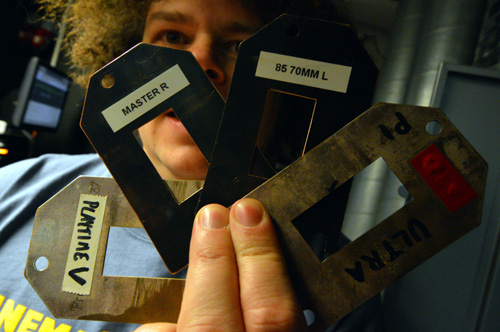 Jan
Olsen showing his masking plates from various 70mm formats: The Master, Play
Time, Out of Africa and for Ultra Panavision 70 - the last one soon to be
used for Mr. Tarantino's soon-to-come 70mm splatter film "The Hateful Eight" Jan
Olsen showing his masking plates from various 70mm formats: The Master, Play
Time, Out of Africa and for Ultra Panavision 70 - the last one soon to be
used for Mr. Tarantino's soon-to-come 70mm splatter film "The Hateful Eight"My second Oslo visit was a few year later in 1998 when Morten Skallerud and I interviewed Louis de Rochemont on video for the "Cinerama Adventure" documentary by David Strohmaier. Unfortunately most of it was left unused. Maybe I will add it to the in70mm.com YouTube channel. |
|
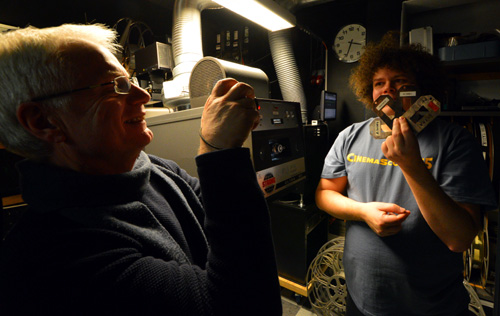 The
DP70 masking plates are worshipped by connoisseurs - in this case, Orla from
Biffen in Aalborg (Denmark). The
DP70 masking plates are worshipped by connoisseurs - in this case, Orla from
Biffen in Aalborg (Denmark).My latest visit was just a few years ago when I interviewed the remaining "Windjammer" crew for the Blu-ray release. Again Morten was behind the camera when we did all the interviews during one weekend, in one of Jan's cinemas at the Cinematek. With Espen Jørgensen producing, making time schedules, getting pizzas and making sure we kept the time table right, it was a very intense weekend, and also very exciting. Not least to hear Lasse Kolstad sing "Kari Waits for Me" right next to us with his wonderful baritone voice.... |
|
2015 Film Screenings |
|
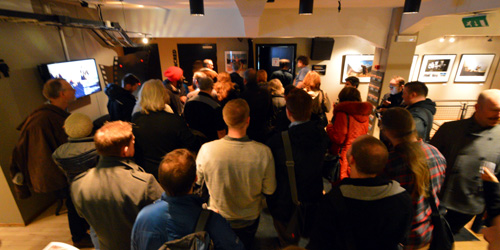 The
audience are lining up to be let into the cinema to see "El Cid" in a rare
Finnish 70mm print with dual Swedish/Finnish subtitles. The
audience are lining up to be let into the cinema to see "El Cid" in a rare
Finnish 70mm print with dual Swedish/Finnish subtitles.Friday afternoon after lunch we came back to the cinema to test run the 65mm reel I had brought to Oslo. It all looked fine, and ran through the DP70 without problems. It is a nice cinema with red seats and a red curtain. There is a nice drop between each row, so each audience member have a perfect unobstructed view of the screen. The side walls and ceiling are all black. Mind the steps when you walk down through the rows. There is no light on the steps, so it is easy to fall if you are not careful. |
|
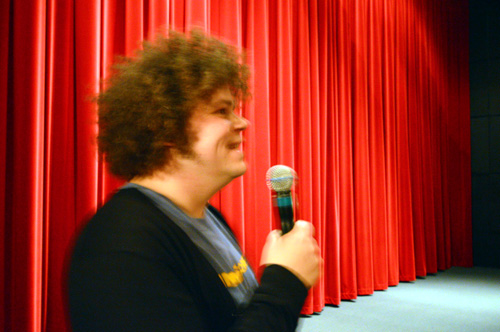 Jan
E Olsen introducing this performance Jan
E Olsen introducing this performanceThe cinema is called "Tancred", and I asked Jan about that name. "The name of the cinema, Tancred, is taken from the director Tancred Ibsen, who made many of the most famous Norwegian films in the '30s and '40s." Jan continued to explain the technical details about the cinema. The cinema was built in 1996, and has 195 seats. The screen size for 70mm is approx 10 meters x 4,5 meters. Five Electro Voice VariplexII speakers (re-vamped with BMS drivers) behind the screen, as well as d & b JSUB. For surround speakers, Meyer HMS-12s and HMS5s are set up for 5.1, 7.1 and Dolby Atmos (as well as Meyer subwoofers for surround bass). |
|
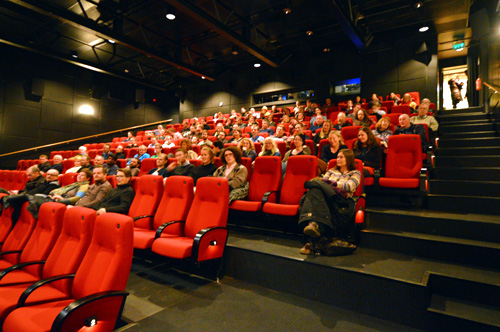 Festival
audience ready to go "Super Technirama 70" the following three hours. One
English gentleman had travelled to Oslo only to see "El Cid". Festival
audience ready to go "Super Technirama 70" the following three hours. One
English gentleman had travelled to Oslo only to see "El Cid".Before the first festival film the same evening, I had to go back to the hotel to rest a bit. I had gotten out of bed at 4 am the same morning and was a bit tired by now. Orla and Henning took a walk to find some sandwiches we could eat before "El Cid" at 18:00. Well seated on the 4th row, a bit off to the right, the curtains opened to reveal "El Cid" in the - almost - splendour of 70mm. By that I mean, the film print was faded - no surprise there, but it was 70MM! Jan Olsen had been looking for a 70mm print for many years and had found one in Finland. The print was in mechanically very good condition, and the show continued for three hours without a glitch. During the intermission I went to the bar to get some beers. I chose the Spanish beer, which Orla and I thought went well with a film which takes place in Spain. |
|
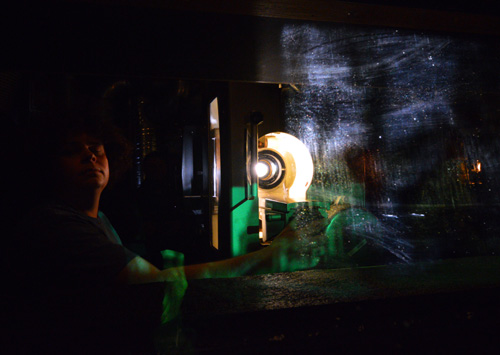 Jan
Olsen next to the DP70 Jan
Olsen next to the DP7070mm at the Cinematek is shown with changeovers, which means the film is shown reel-by-reel on two alternating projectors. Every 15-20 minutes, a reel change is required. To the average audience this is not noticed, nor should it be. Running films with changeovers requires both machines to be adjusted very precisely to match the same level of sharpness and light on the screen. It was nice to follow the change overs, following the cue marks in the upper right corner of the screen. The marks go unnoticed by most people, but ever since the birth of the the 2-reeler (I suppose), some sort of marks have been necessary for the projectionist to run the film. He/she had to know when to change reel from projector 1 to projector 2. Anyway, these sort of things are not seen since the introduction of digital projection. The Cinematek's projectors are vintage Philip's DP70s with more than 60 years of 70mm history behind them. |
|
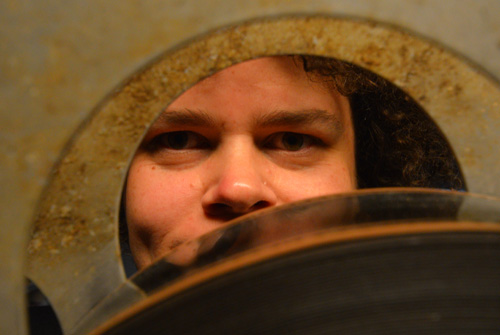 Jan
making a perforation count... Jan
making a perforation count...During the intermission and breaks I SMSed with Morten about meeting for lunch the next day. We settled for a 11:30 rendezvous in front of the cinema to have lunch. We continued our 70mm evening with "Kelly's Heroes" in full 70mm with 6-track magnetic stereo. The film was shown without intermission, and ended just before midnight. Home to our hotel just around the corner. Sorting the images of the day, adding them to the web site, and then sleep. |
|
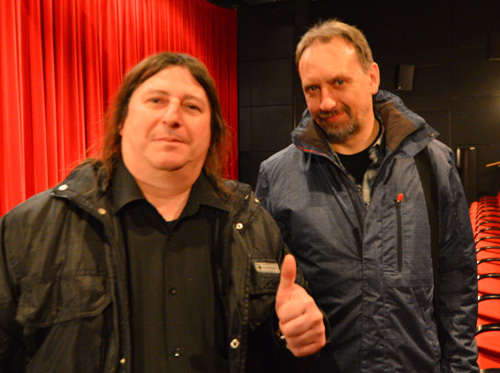 Martin
and Pawel from Krnov in the Czech Republic Martin
and Pawel from Krnov in the Czech RepublicMaria and I woke up, had our breakfast and then we went out for a walk. The nearby opera house was our goal for the morning. The way it is designed you can actually walk to the top of the building and have a splendid view of Oslo's harbour. The snow came down ever so lightly this morning, and reminded us to wear something extra to keep warm. In the distance we could see the mountains. The view must be even more spectacular in 70mm and during summer when the sky is blue. Morten sent me an SMS - "I'm on the train, and will arrive shortly", and sure enough, a couple of minutes later he turned around the corner. Almost at the same time Orla and Henning arrived too. We all agreed we all had had breakfast just recently, and didn't really need lunch. We settled for cakes and tea / coffee in a nearby Pascal Konditori. For about an hour we sat and talked about Morten's "A Year Along the Abandoned Road" and his most recent work, the follow-up to "Solan og Ludvig - Jul i Flåklypa", which itself was a follow up to "Flåklypa Grand Prix" from 1975, which I mentioned at the top of this page. |
|
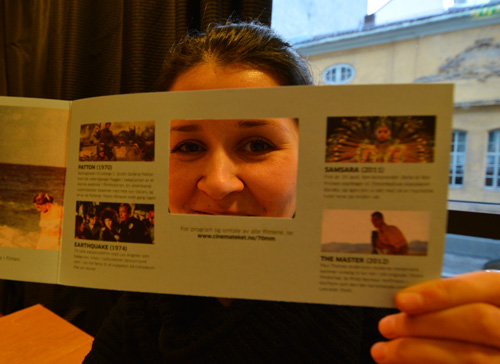 Adele
from Krnov in the Czech Republic Adele
from Krnov in the Czech RepublicAt 14:00 in the afternoon I gave my lecture called "The Early Days of Todd-AO". My Danish supporters Henning, Maria and Orla were there to cheer (or throw rotten tomatoes). Torkell, an old Norwegian 70mm friend, also came to hear the lecture and say hello. Our paths rarely cross so it was pleasing that he came. Morten also stayed to see and listen to the lecture. It was a good audience who were active asking questions during the lecture. About 75 people listened I was told. The highlight of this weekend was to see two master pieces by Sir David Lean in the splendour of 70mm. "Doctor Zhivago" and "Lawrence of Arabia" in 6-track magnetic stereo. Both films are in my 70mm movie top 5, along with "2OO1: A Space Odyssey" and "Hamlet". Good solid movie making. |
|
 Full
house - completely sold out for "Doctor Zhivago" and "Lawrence of Arabia" -
both in the splendour of 70mm Full
house - completely sold out for "Doctor Zhivago" and "Lawrence of Arabia" -
both in the splendour of 70mmThey surely don't make them like this any more. Both prints were used, the Doctor even vintage, and only with few colors left. But to me that is the whole point of seeing them in a cinema. With scratches, change-overs and all the imperfections of film which makes this media come alive in front of your very eyes. I enjoy the texture, depth, colors (even if they are missing), richness of film, the flickering light etc. etc. This is cinema. It's cinema because someone up there is showing this to you. Someone who cares, and who makes an effort making it look as good as possible It was a long afternoon, starting 15:30 with the good Doctor, and ending a couple of minutes before midnight with Lawrence "..going home Sir!". A wonderful afternoon, thanks to all the efforts of Jan Olsen and his staff. Keep up the good work, and thanks for KEEPING 70MM ALIVE! Show it in 70MM and they will come. |
|
| Go: back - top - back issues - news index Updated 22-01-25 |
